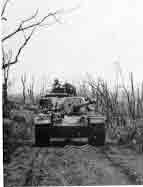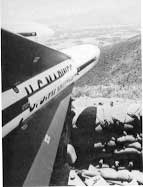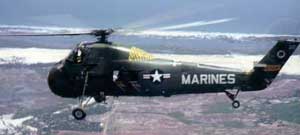| Welcome To Al's Vietnam Home Page
Poems
& Letters A Pictorial Account of
|
U.S. Marines In Vietnam
While every effort has been made to maintain complete, updated and accurate information, this site is not an official source for information about the Vietnam War or the United States Marine Corps. I hope the
material I supplied below will be helpful to all high school and college students learning
about the history of the Vietnam War.
Material found on this page
was supplied from the book titled
"Under
The Gun..." |
|||
Some
of Vietnam's heaviest fighting took place near the Demilitarized Zone.
Operation Hastings, Khe Sanh, and hills designated by numbers or
names came to the attention of folks back home via headlines, radio
bulletins or TV specials. Near the DMZ, Marines met the trained,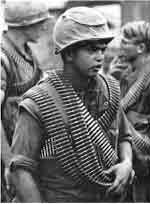 well-supplied NVA. Fighting with his back to his homeland, reinforced
with artillery and mortars, the enemy proved vicious but not indestructible.
They were beaten by air support, armored vehicles, artillery and the
lowly individual Marine grunt. High in the mountains of the northern
provinces, a Marine could look down from his "throne" and
appreciate the beauty during a lull in the battle.
well-supplied NVA. Fighting with his back to his homeland, reinforced
with artillery and mortars, the enemy proved vicious but not indestructible.
They were beaten by air support, armored vehicles, artillery and the
lowly individual Marine grunt. High in the mountains of the northern
provinces, a Marine could look down from his "throne" and
appreciate the beauty during a lull in the battle. |
||||
That's what it was all about below Vietnam's Demilitarized Zone. The enemy did his thing, and you did yours. He shot and you hid, hoping . . . praying, that he'd miss. It wasn't a life as such. It was an existence. It wasn't always that way; it just seemed like it was. According to the 1954
Geneva Accords, the strip of land on each side of the Ben Hai River The partition appeared good on paper, but constant violations by the North changed all that. The DMZ was used by the NVA as a staging area. From this neutral haven, thousands of artillery rounds were to be fired on Marine outposts at Con Thien, Gio Linh, Dong Ha and Cua Viet. Marines moved into the area below the DMZ during "Operation Hastings'' in mid-1966. They quickly established static positions at Khe Sanh, Dong Ha, Camp Carroll, Con Thien and Gio Linh. When the Marines were reasonably settled, the NVA elevated their gun barrels and "greeted" the Americans with a shower of hot steel. NVA units gathered within the comparative safety of the DMZ and then mounted attacks against Marine outposts.
During September 1967, the NVA began a continuous pounding on Con Thien. An average of 500 artillery rounds were fired daily into the small hilltop. Marines held; they also beat off several mass ground assaults. When the communists learned they couldn't penetrate Marine defenses at Con Thien, they swiveled their guns and hit Khe Sanh. For 77 days, NVA gunners surrounded and pounded. It was called a "siege." (On February 23, enemy guns in Laos fired 1307 artillery rounds into Khe Sanh.) Some said it was to be another Dien Bien Phu. The Marines held, and the "siege" lifted on April 7, 1968. Marine casualties had been light. The Marines were fed up. They had lived under the gun long enough. They began to move ... move fast, and they struck hard. The mobility concept was set in motion. Helicopters hovered atop craggy mountain crests and the Marines charged to meet the enemy. Instead of Marines humping up mountains, the whirlybirds set them down on top, and the Marines chased the NVA, gaining momentum from the slopes of the hills. During ''Operation Dewey Canyon," the Ninth Marines captured six Russian-made 122mm artillery pieces along with tons of ammunition and NVA supplies. Terrain was no longer an obstacle. The Marine mobility posture caught the enemy unaware and kept him on the move. Once landed on a mountaintop, an LZ was established and Marine choppers ferried in artillery support. It was Nguyen's turn in the barrel, but Marines knew it wasn't over . . . not yet. Located so close to
North Vietnam, the entire NVA army, mortars, rockets and artillery are
poised on the other side of the DMZ. Marines are still under the gun.
|
||||
Please stop back
Special Thanks to
Thanks for stopping by
|

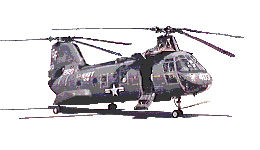
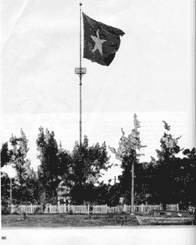
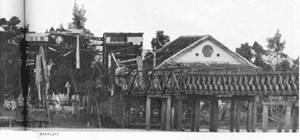
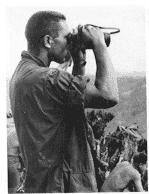
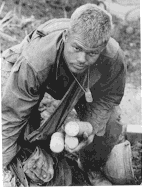 (separating North and South Vietnam) and running the entire 38-mile width
of the country would be demilitarized. No military activity was to be
permitted in the DMZ.
(separating North and South Vietnam) and running the entire 38-mile width
of the country would be demilitarized. No military activity was to be
permitted in the DMZ.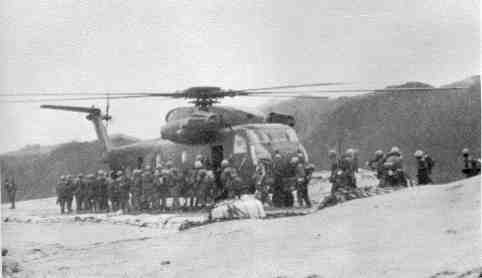
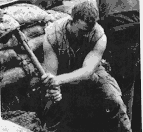
 When word was
passed to halt and set up a defense, Marines shrugged off their packs,
placed their weapons nearby and immediately began digging in. When Nguyen's
guns opened up from the DMZ, Marines caught in the open were targets for
shrapnel and hurtling rocks. Others, transported to mountain observation
posts by helicopter, maintained a constant vigil on the Ho Chi Minh trail or
other routes of infiltration. Even at night, aided by infrared telescopes
such as the "Starlight" scope, Marines could observe known enemy
routes of march, reporting movement to Marine artillery batteries which
bombarded the infiltrators. And as the Marines moved and neutralized, they
modernized.
When word was
passed to halt and set up a defense, Marines shrugged off their packs,
placed their weapons nearby and immediately began digging in. When Nguyen's
guns opened up from the DMZ, Marines caught in the open were targets for
shrapnel and hurtling rocks. Others, transported to mountain observation
posts by helicopter, maintained a constant vigil on the Ho Chi Minh trail or
other routes of infiltration. Even at night, aided by infrared telescopes
such as the "Starlight" scope, Marines could observe known enemy
routes of march, reporting movement to Marine artillery batteries which
bombarded the infiltrators. And as the Marines moved and neutralized, they
modernized.